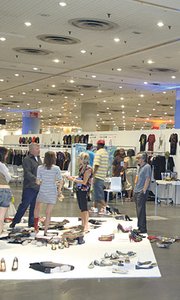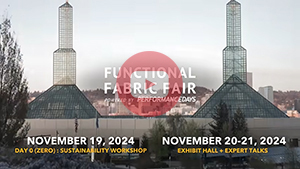Pool Show Bows in N.Y. With Project by Its Side
NEW YORK—The oppressive mid-July heat meant that New York’s Jacob K. Javits Convention Center was an absolute haven of cool—in every sense of the word—for the 6,500 attendees of the July 17–19 summer Pool Trade Show and Project Global Trade Show. Last year, Advanstar Communications Inc. acquired both shows, bringing them into the same fold with the MAGIC Marketplace in Las Vegas.
The two shows were exhibiting here under the same roof, making it an air-conditioned one-stop-shopping experience. This was Pool’s first foray to the East Coast after building a strong reputation in Las Vegas since its 2001 launch.
“This first show is just a scratch on the surface for Pool in New York,” said Tommy Stefanek, Pool’s trade show coordinator. “In Las Vegas, there are about 500 exhibitors, and at this show, we have under 200,” he said, “but we expect it to grow here into what it has become on the West Coast.
“And the pairing with Project is ideal because they are the same but different— they work very well together, but there isn’t a conflict of interest,” Stefanek said.
There was a very different feel to the shows, which was noticed by some of the buyers and 158 exhibitors alike.
“I love the way it looks in Pool,” said Elisabeth Ganson, representing her sister Audrey Woollen’s Urbanic store in Santa Monica, Calif. “I actually saw a lot more interesting stuff at Pool than I did at Project, but I do feel like it seems a little exclusive, tucked off to the side, and I feel like the lighting is much darker over there—it almost feels slightly unapproachable, which is the opposite of how the exhibitors are.”
While gesturing over to the bright lights of Project, Shane Small, partner and art director of Edoc Laundry in Seattle, said: “This morning, I would walk over and peer in, and I was almost wishing I could be there, stuck right in the buzz of things. But actually I have started to really feel excited about being here at Pool. I am beginning to really enjoy the atmosphere.”
Perhaps due to the fact that it was quieter at Pool, exhibitors had the chance to spend a little more time explaining their lines to prospective buyers, such as with Edoc Laundry, whose designs incorporate hidden messages that the garment’s owners can then type into a Web site and uncover the next stage of a rock ’n’ roll murder mystery story.
“It has really grabbed people’s attention,” enthused Catherine Brigg, partner and women’s designer. “Already there are other Web sites that people have set up independently that are following and trying to figure out the story.”
Charlotte, N.C.–based Olveok is another company that is crossing the boundaries of pure fashion and taking it to another level. “We give a portion of our revenue to the International Rescue Committee,” said owner/ designer Oksana Nikonova. The collection’s T-shirts have a spiritual, Tibetan influence and a tagline that reads: “Be in Style with Yourself.”
Although Pool tended to be a very Tshirt– driven show—with Edoc Laundry, Olveok, Dangerous Breed, Deadly Girl Couture, and the very cool and self-proclaimed “wicked awesome” Black Black Label of Atlanta—there were certainly a few that swerved from that theme. Foat Design, based in Minneapolis, is owned by twin sisters Kaja and Zoeuml; Foat, who create urban yogawear from recycled wool. And then there was Velvet Leaf from San Francisco—also designed by a sister team, Becky and Laura Carter—whose beautiful “Little House on the Prairie” designs are made entirely from organic materials.
At Project, which is typically thought of as a denim-based show, the usual suspects were all very apparent among the 360 exhibitors— Antik Denim, Hudson Jeans, Mynk, Earnest Sewn and True Religion, whose saloon-style booth resplendent with bar stools had attendees yearning for a shot of something strong.
Yet another major theme was emerging— the re-launch of retro gear such as Le Tigre, Original Penguin and first-time exhibitor Jed. Mark Lowenthal, owner of Los Angeles– based Jed, decided to re-launch his line, which first had success in the late ’80s, after noticing that menswear was again returning to a need for quality garments that men could wear with their designer jeans.
“Guys don’t all necessarily want that slim rock-star silhouette,” Lowenthal said. “But they also don’t want to see a hundred or so other guys wearing the same chain-store jersey they are wearing.” He sees Jed’s argyle and striped knits as fitting into this niche perfectly.
Talking of rock stars, one of Project’s standout shows was Los Angeles–based Rokara, set up by Drew Bernstein and Rick Lohr after they met about a year ago.
“’Takara’ is Japanese for treasure,” explained Bernstein, “and ’Rok’ because we are rockers.” Their ultra-hip men’s jeans, tees and reversible hoodies, and vintage-inspired womenswear—including the “Femme Fatale” military-inspired coat—secured them four huge accounts, including Fred Segal and Blake in Portland, Ore., on the very first day.
Maybe it was the heat, but by day three of the show, people seemed a little worn down. Many of the Pool exhibitors said they felt they hadn’t seen nearly enough buyers. Olveok’s Nikonova said: “There seems to be a look-now-buy-later attitude in New York,” as opposed to the West Coast, which tends to be all business right then and there.
Hyden Yoo of the New York store Namja Yeoja agreed. “I have seen some stuff here [at Pool] that really interests me and that I probably will come back to later,” he said at the end of the last day. “I didn’t feel like there was so much to see at Project—Pool seems much funkier and hipper to me. It’s not as good as the Las Vegas Pool, but give it time.”























